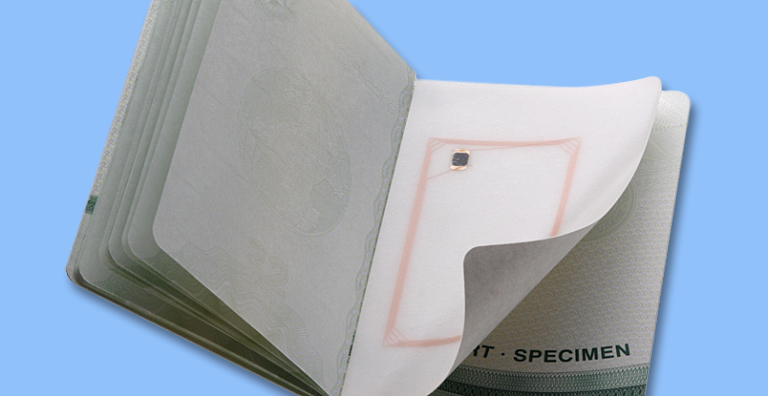Where to Position the Chip in an ePassport
I am often asked the question, “What determines the location of a chip in a passport booklet?” With the recent trend towards polycarbonate datapages the options as to where to put the microchip and its antenna have increased. So, is there an optimum location?
Standards Determine the Location of the Chip
The first place to look in these situations is to the standards. ICAO9303 allows for eight different locations and orientations which include the datapage, front or back cover and — perhaps less intuitively — between visa pages. However, the eighth option is “other” which leaves the decision open to the discretion of the issuing state.
Four Additional Factors Have an Impact on Chip Location
The additional factors that determine the position of the chip can be summarized as follows:
Security. ICAO recommends splitting and layering security features to prevent whole page substitution, making life more difficult for a potential counterfeiter. Therefore, it makes sense to put the chip somewhere other than in the polycarbonate datapage thereby ensuring that even if the datapage is removed, the personal details of the passport holder still remain in the booklet.
Datapage Thickness and Aesthetics. When positioning the chip in the polycarbonate datapage it usually results in an increase in thickness of the page in order to fully encapsulate and protect it from damage. But this increase comes with a compromise to the flexibility of the booklet, making it feel more solid in the hand. This can be mitigated to an extent by the use of a flexible, anti-crack layer in the datapage. On the other hand, by putting the chip in the cover, the cover and end pages become thicker leading to aesthetic problems such as gape.
Sourcing. The sourcing strategy for a particular passport scheme may determine where the chip is located in a book, particularly if the components for the booklet are being sourced separately. It can be more efficient and cost effective to have one single source for components, in which case a polycarbonate datapage with chip would be preferred.
Passport Design History. The previous design of passport booklet can often have an impact in the design of the next generation. Often the equipment used to make a booklet or to personalize it will be adjusted to suit a particular design of booklet. If there is no budget to modify equipment, it often makes sense to stay with the same design and position of the chip.
There Is No Right or Wrong: Every ePassport Is Unique
As you can see, the position of the chip in a booklet is influenced by a number of factors, some of which are less obvious than others. There is no right or wrong answer when making this decision. Chip position placement must take into account design, security, manufacturing equipment, business strategies and aesthetic preferences. This makes it impossible to recommend where a chip should be located in the booklet, as it must suit the particular circumstances of the passport project. What is comforting is that there have been successful projects with chips in all the mentioned positions, so a passport designer can be reassured that whichever option is taken, if well implemented, it will be successful.
Learn out more about HID's chip operating system for identity documents.
Frederic Jacquot has been the Product Manager for HID Global’s ePassport and eID solutions for the past four years. Previously, he worked in Sales in APAC. He supports our global ePassport and eID business from Spain.
